活动地址:CSDN21天学习挑战赛
完成了深度学习环境搭建和卷积神经网络(CNN)实现mnist手写数字识别的学习实践,最后总结了一下知识点,今天,继续跟着老师学习卷积神经网络(CNN)服装图像分类。
- 本文为🔗365天深度学习训练营 中的学习记录博客
- 参考文章地址: 🔗深度学习100例-卷积神经网络(CNN)服装图像分类 | 第3天
学习总结如下:(代码附后)
1、数据分析
1.1 了解fashion_mnist数据集
老师加载数据集: datasets.fashion_mnist.load_data()
用到的是:fashion_mnist数据集
FashionMNIST 是一个图像数据集。 它是由一家德国的时尚科技公司提供。其涵盖了来自 10 种类别的共 7 万个不同商品的正面图片。FashionMNIST 的大小、格式和训练集/测试集划分与原始的 MNIST 完全一致。60000/10000的训练测试数据划分,28x28 的灰度图片。
数据分类说明:
| 标签值 | 分类 |
|---|---|
| 0 | T恤 / 上衣 (T-shirt/top) |
| 1 | 裤子 (Trouser) |
| 2 | 套衫 (Pullover) |
| 3 | 连衣裙 (Dress) |
| 4 | 外套 (Coat) |
| 5 | 凉鞋 (Sandal) |
| 6 | 衬衫 (Shirt) |
| 7 | 运动鞋 (Sneaker) |
| 8 | 包 (Bag) |
| 9 | 短靴 (Ankle boot) |
数据可视化预览:

1.2 分析数据集
与刚刚学过的手写识别数据集相比较,这次的服装分类数据集特点明显,即像数据复杂度:服装分类的数据复杂度要明显高于手写数据。
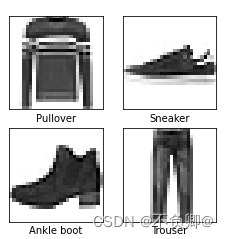
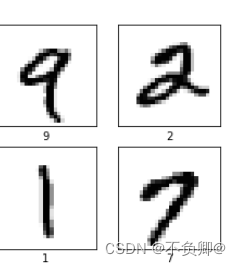
数据大小:同样都是7 万个样本,训练集/测试集划分一致:60000/10000,28x28 的灰度图片。
分类情况:都是多分类(10分类)
2、模型搭建
与手写识别模型比较,多增加了一个卷积层,我们上节总结了,卷积层的作用是:用于从输入的高维数组中提取特征。卷积层的每个卷积核就是一个特征映射,用于提取某一个特征,卷积核的数量决定了卷积层输出特征个数 。
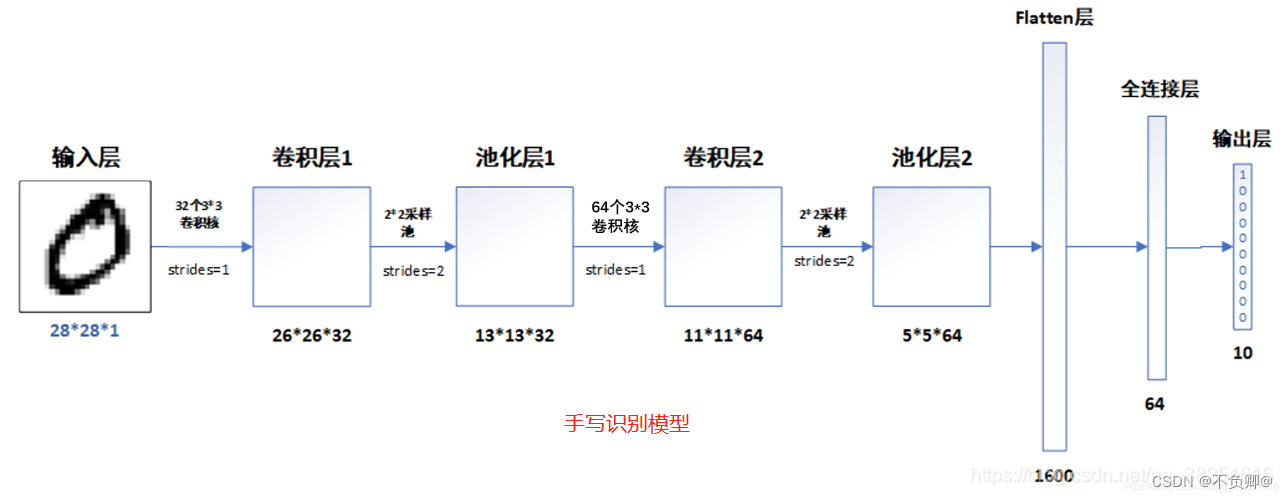

model = models.Sequential([
layers.Conv2D(32, (3, 3), activation='relu', input_shape=(28, 28, 1)), #卷积层1,卷积核3*3
layers.MaxPooling2D((2, 2)), #池化层1,2*2采样
layers.Conv2D(64, (3, 3), activation='relu'), #卷积层2,卷积核3*3
layers.MaxPooling2D((2, 2)), #池化层2,2*2采样
layers.Conv2D(64, (3, 3), activation='relu'), #卷积层3,卷积核3*3
layers.Flatten(), #Flatten层,连接卷积层与全连接层
layers.Dense(64, activation='relu'), #全连接层,特征进一步提取
layers.Dense(10) #输出层,输出预期结果
])
使用model.summary() , 打印网络结构,如下:

3、配置模型
因为和手写识别模型一样,都是用于训练分类,所以,此处用到的优化器、损失函数、指标参数一致。
model.compile(optimizer='adam',
loss=tf.keras.losses.SparseCategoricalCrossentropy(from_logits=True),
metrics=['accuracy'])
4、训练模型
history = model.fit(train_images, train_labels, epochs=10,
validation_data=(test_images, test_labels))
- validation_data=(测试集输入特征,测试集标签)
- epochs = 迭代次数
这里的history是接收模型训练返回的数据,其中包含:
- loss:训练集损失值
- accuracy:训练集准确率
- val_loss:测试集损失值
- val_accruacy:测试集准确率
我们打印看看:print(history.history)

训练过程:
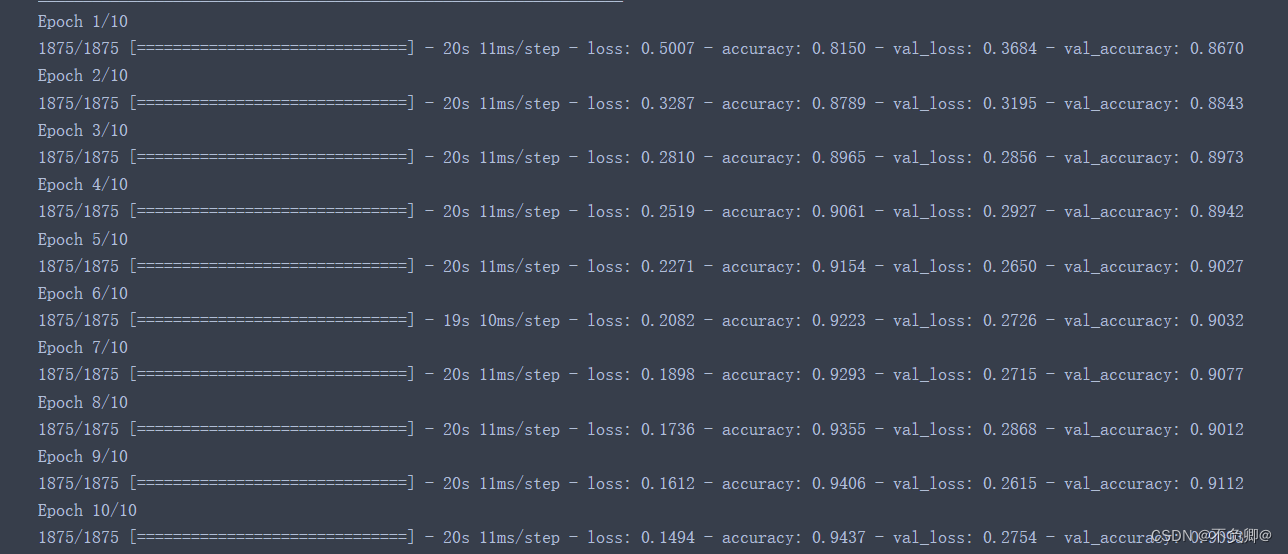
输出说明:
- loss:训练集损失值
- accuracy:训练集准确率
- val_loss:测试集损失值
- val_accruacy:测试集准确率
5、测试集预测
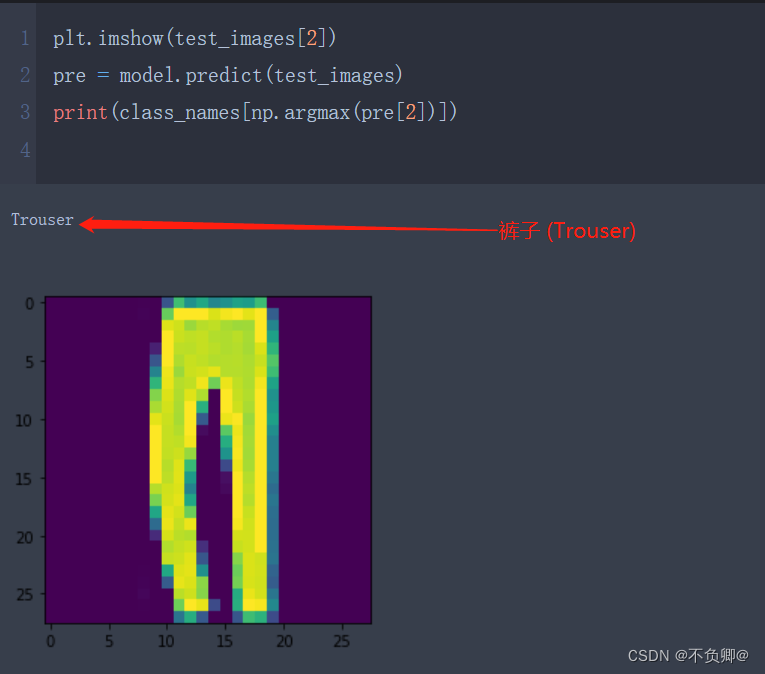
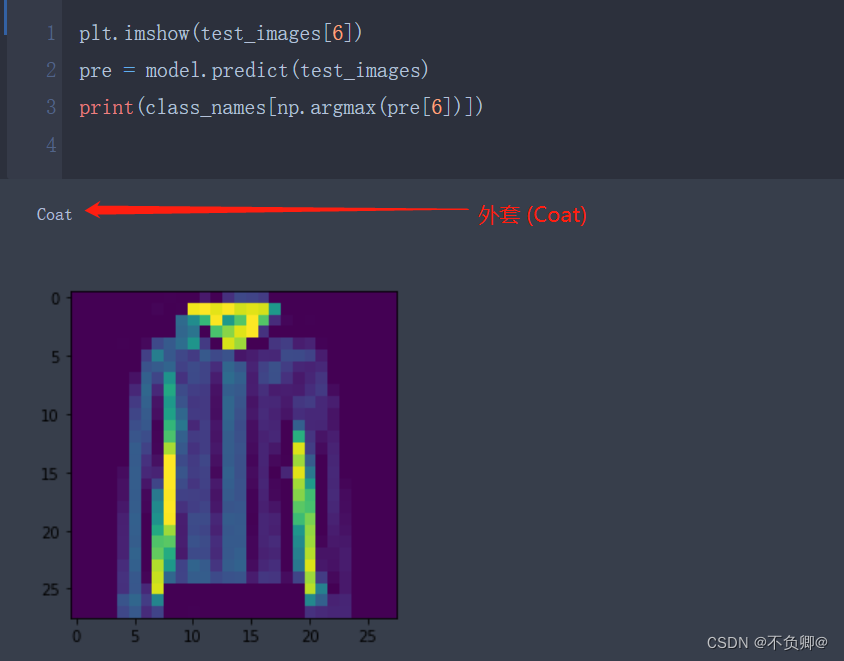
6、模型评估
plt.plot(history.history['accuracy'], label='accuracy')
plt.plot(history.history['val_accuracy'], label = 'val_accuracy')
plt.xlabel('Epoch')
plt.ylabel('Accuracy')
plt.ylim([0.5, 1])
plt.legend(loc='lower right')
plt.show()
test_loss, test_acc = model.evaluate(test_images, test_labels, verbose=2)
print("测试准确率为:",test_acc)
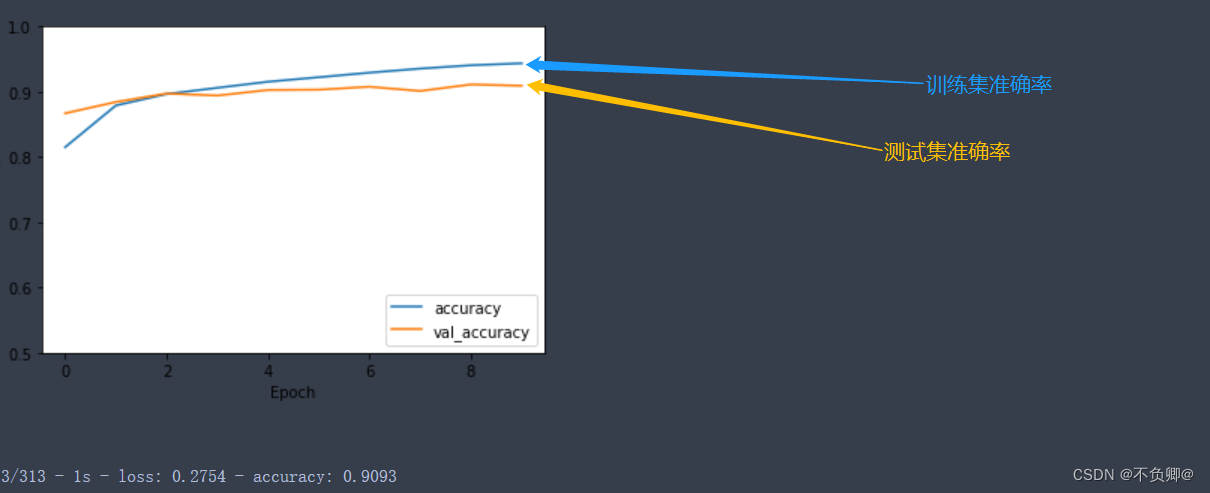

7、完整代码
import tensorflow as tf
from tensorflow.keras import datasets, layers, models
import matplotlib.pyplot as plt
import numpy as np
(train_images, train_labels), (test_images, test_labels) = datasets.fashion_mnist.load_data()
train_images, test_images = train_images / 255.0, test_images / 255.0
#调整数据到我们需要的格式
train_images = train_images.reshape((60000, 28, 28, 1))
test_images = test_images.reshape((10000, 28, 28, 1))
class_names = ['T-shirt/top', 'Trouser', 'Pullover', 'Dress', 'Coat',
'Sandal', 'Shirt', 'Sneaker', 'Bag', 'Ankle boot']
plt.figure(figsize=(20,10))
for i in range(20):
plt.subplot(5,10,i+1)
plt.xticks([])
plt.yticks([])
plt.grid(False)
plt.imshow(train_images[i], cmap=plt.cm.binary)
plt.xlabel(class_names[train_labels[i]])
plt.show()
model = models.Sequential([
layers.Conv2D(32, (3, 3), activation='relu', input_shape=(28, 28, 1)), #卷积层1,卷积核3*3
layers.MaxPooling2D((2, 2)), #池化层1,2*2采样
layers.Conv2D(64, (3, 3), activation='relu'), #卷积层2,卷积核3*3
layers.MaxPooling2D((2, 2)), #池化层2,2*2采样
layers.Conv2D(64, (3, 3), activation='relu'), #卷积层3,卷积核3*3
layers.Flatten(), #Flatten层,连接卷积层与全连接层
layers.Dense(64, activation='relu'), #全连接层,特征进一步提取
layers.Dense(10) #输出层,输出预期结果
])
model.summary()
model.compile(optimizer='adam',
loss=tf.keras.losses.SparseCategoricalCrossentropy(from_logits=True),
metrics=['accuracy'])
history = model.fit(train_images, train_labels, epochs=10,
validation_data=(test_images, test_labels))
plt.imshow(test_images[1])
pre = model.predict(test_images)
print(class_names[np.argmax(pre[1])])
plt.plot(history.history['accuracy'], label='accuracy')
plt.plot(history.history['val_accuracy'], label = 'val_accuracy')
plt.xlabel('Epoch')
plt.ylabel('Accuracy')
plt.ylim([0.5, 1])
plt.legend(loc='lower right')
plt.show()
test_loss, test_acc = model.evaluate(test_images, test_labels, verbose=2)
print("测试准确率为:",test_acc)
学习日记
**
1,学习知识点
a、认识和使用fashion_mnist数据集
b、卷积神经网络(CNN)对复杂样本分类识别的基本使用
c、模型评估方法
2,学习遇到的问题
继续啃西瓜书,恶补基础

























 9857
9857











 被折叠的 条评论
为什么被折叠?
被折叠的 条评论
为什么被折叠?










